Domestic army body armor
In the confrontation of the damaging elements and NIB (means of individual armor), the advantage will always remain in the first place. After all, if the design of the projectile and the energy transferred to it can be changed and built up to achieve greater efficiency and power, the armor, which is also being improved, continues to be carried by a vulnerable person, who, unfortunately, cannot be modernized.

Revival cuirass.
Fire Spread weapons, its use in military affairs and the sharply increased power of the damaging elements caused the armor and armor to become obsolete, since for bullets they ceased to be an obstacle and only burdened their owners. However, the results of the Inkerman 1854 battle of the year, in which the Russian infantry was shot as targets in the shooting range, caused the commanders to think not only about changing the traditional tactics of military operations, but also about protecting the soldiers. After all, the soldier was protected from the deadly metal only by a thin cloth of his uniform. This provision was not a concern, as long as the battles were an exchange of musket volleys and a subsequent hand-to-hand combat. However, the emergence of rapid-fire artillery, which covered the battlefields with fragmentation grenades and shrapnel, rapid-rifle guns, and later machine guns, led to the loss of armies monstrously increased.
Generals treated the lives of soldiers in different ways. Some respected and cherished them, some believed that death in battle for an actual man was honorable, and for some soldiers were common consumables. However, despite the different relationships, they all agreed that huge losses would not allow to win the battle or lead to defeat. The most vulnerable were the fighters of the infantry battalions going to the attack first, and the sapper companies, also acting on the front, because it was on them that the enemy concentrated the main fire. In this regard, the idea arose to find the protection of these fighters.
The first on the battlefield tried to return the shield. In Russia, in 1886, the steel shields of the design of Colonel Fisher were tested. They had special windows for shooting. However, they turned out to be ineffective due to the small thickness - a bullet fired from a new rifle could easily shoot through the shield.
Another project turned out to be more promising - cuirass (armor) began to return to the battlefield. Fortunately, this idea was before our eyes, since at the turn of the XIX — XX centuries. the cuirass was part of the ceremonial uniform of the soldiers of the cuirassier regiments. It turned out that a simple old-style breastplate, the main purpose of which was protection against edged weapons, withstands an 7,62-millimeter bullet fired from Nagan from a distance of several tens of meters. Accordingly, a slight thickening of the cuirass (naturally to reasonable limits) would protect the fighter from shots from more powerful weapons.
This was the beginning of the revival of the cuirass. Russia for its army in February 1905 ordered 100 thousand infantry cuirass from the company Simone, Hesluen and Co (France). However, the purchased item was unusable. Reliable proved domestic remedies. Among their authors, the most famous is Lieutenant Colonel A. A. Chemerzin, who made the cuirass of various steel alloys of his own design. This talented person can no doubt be called the father of a Russian bulletproof vest.
The Central State Military Historical Archive keeps a brochure, sewn into one of the cases, under the title “Catalog of shells invented by Lieutenant Colonel A. A. Chemerzin”. It contains the following information: "The weight of the shells: 11 / 2 pounds (1 pound - 409,5 grams) - the lightest, 8 pounds - the heaviest. Invisible under clothing. The armors are designed against rifle bullets. The armors that have an 8 weight of pounds not pierced by 3 -line military rifle. Arms close: heart, abdomen, lungs, both sides, back and spinal column against the heart and lungs. The penetrability of each shell in the presence of the buyer is checked by shooting. "
The "Catalog" contains several test reports of protective shells, which were conducted in 1905 — 1907. In one of the acts it was reported: “In the city of Oranienbaum 11, June 1905, in the presence of HIS IMPERATOR MAJORITY STATE IMPERATOR, was fired by a machine-gun company X.XXXXXXXXXXXX-1. the bullets hit the shell. It was not pierced, there were no cracks in it either. During the tests there was a variable composition of the rifle school. "
In addition, shells were tested in the reserve of the Moscow police, and they were made to order. Shooting was fired at them from a distance of 15 steps. The act noted that the shells "turned out to be impenetrable, and the bullets did not give splinters. The first batch made was satisfactory."
The act of the reserve commission of the St. Petersburg Metropolitan Police contains the following entry: "During the test, the following results were obtained: shooting a chest shell weighing 4 pounds 75 spools (spool equal to 4,26 g) and dorsal shell weighing 5 pounds 18 spools that were wrapped in thin the silk fabric covering the chest, sides, abdomen and back, piercing through the bullets, deform and create depressions on the shell, but do not penetrate it, remaining between the shell and the matter, and the bullet fragments do not fly out. "
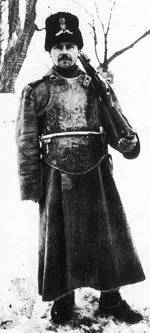
In Russia, cuirass became very popular by the beginning of the First World War. They provided the Metropolitan Police - to protect revolutionaries and knives from criminals from bullets. Several thousand were sent to the army. Concealed wearing cuirasses (under clothing) despite the high cost (1,5 - 8 thousand rubles) were also interested by civilians, who feared armed robberies. Alas, the first demand for these prototypes of civilian body armor became the reason for the appearance of the first crooks who took advantage of this demand. Promising that the product offered by them is not shot through even with a machine gun, they sold cuirass that did not stand the test.
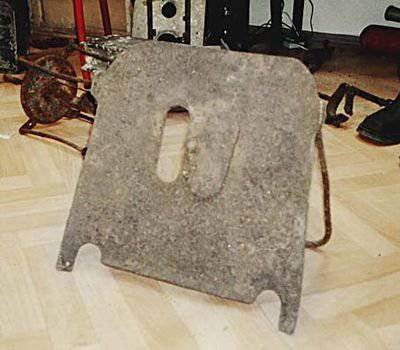
In the First World War, along with the cuirass, armor-hits were widely spread, which showed little effectiveness during the Russian-Japanese war of 1904-1905, which, after revision, received improved bullet-proof performance. On land, hostilities acquired a positional character, and the war itself became “fortress” everywhere. The greatest practical application was received by the simplest device shield - a steel rectangular sheet 7 millimeters thick with a stand and a loophole for a rifle (apparently such a shield resembled the armor-like machine gun Maxim). First of all, the shield of this design was intended for combat operations in the defense: it was installed on the parapet of the trench permanently for the observer (sentry). The extent to which these shields have spread, is indicated by the fact that the use of shields after the war was reinforced by military regulations. Thus, the “Manual on military engineering for infantry of the Red Army”, which was put into effect in September 1939, determined the use of a portable shield in defense and illustrated how to use it - in the illustration to the text, a rectangular shield measuring 45 40 centimeters is rooted to the bone in the parapet before rifle loophole. The 1914-1918 combat experience was so successful that the portable shields were used during the Finnish-Soviet 1939-1940 war and the initial period of the Second World War.
During the First World War, cuirass and similar means of protection were used not only by Russia, but also by other countries. Testing in practice showed both advantages and disadvantages of these types of protection. Of course, it is well protected body and vital organs. But the resistance of the cuirass is directly dependent on the thickness. Light and thin absolutely did not protect against large fragments and bullets, and the thicker because of its weight did not allow to fight.
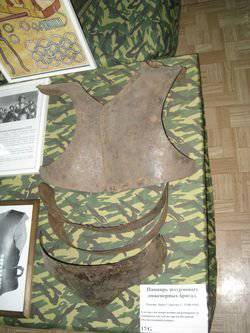
A relatively good compromise was found in 1938, when the Red Army received the first experimental steel breastplate CH-38 (CH-1) in service. This breastplate protected only the chest, abdomen and groin of the fighter. Thanks to savings on back protection, it became possible to increase the thickness of the steel sheet without overloading the fighter. However, all the weaknesses of this solution were identified during the Finnish company, and therefore the development of the CH-1941 breastplate (CH-42) began in 2. The creators of this bib became the armored laboratory of the Institute of Metals under the leadership of Koryukov.
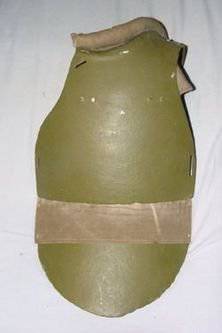
Steel bib consisted of two 3-mm plates - the top and bottom. This solution was applied, because in the whole breastplate the soldier could not bend down or sit down. Such a "shell" soldiers, as a rule, put on a padded jacket without sleeves, which was an additional shock absorber. The soldiers used padding jackets even though the bib had a special lining on the inside. However, there have been cases when a bib was worn on top of a camouflage or even overcoat. CH-42 defended from fragments, gunfire (at a distance of more than 100 meters), but could not withstand shots from a machine gun or rifle. First of all, steel bibs were equipped with the RVGK ShISBr (assault engineering-sapper brigade of the High Command). This protection was used in the most difficult areas: during street battles or taking powerful fortifications.
However, the assessment of the effectiveness of such a breastplate by the front-line soldiers was the most controversial, from flattering to complete rejection. However, after analyzing the combat path of these “experts,” the following paradox turns out: the breastplate was valued in the assault units of the “taking” large cities, and in the units that captured the field fortifications they received negative reviews. "Shell" protected the chest from fragments and bullets while the soldier ran or walked, as well as during the melee, so he was needed in battles on city streets. At the same time, in field conditions, sapper-attack aircraft, as a rule, moved in belligerence. In this case, the steel bib was an unnecessary hindrance. In the units of the leading battles in sparsely populated areas, the breastplates first migrated to the battalion depots, and later to the brigade ones.
From the memoirs of the front-line soldiers: “Senior sergeant Lazarev, rushing forward, ran to the German dugout. He was met by a fascist officer who discharged an assault rifle into the attacker's chest, but didn’t take the daredevil’s bullets. He used a butt to hit the head of the officer. and went into a dugout. There he laid several fascists who simply became insane from what he had seen: the officer shot the Russian at point-blank range, and he remained unharmed. " There were many similar cases during the battles and the Germans who were captured asked many times to explain the reason for the “indestructibility of the Russian soldier”. I had to show the shield.
CH-46 entered service in 1946, and became the last steel bib. The thickness of the CH-46 was increased to 5 mm, it allowed to resist the queue of MP-40 or PCA at a distance of 25 meters. For greater convenience, this model consisted of three parts.
After the war, almost all breastplates were handed over to warehouses. Only a small part of them was transferred to the formed units of the Main Intelligence Directorate of the General Staff of the Armed Forces of the USSR.
The first domestic body armor.
But world practice has shown that it is necessary to create effective armor protection for ordinary soldiers and protect them on the battlefield from shrapnel and bullets. The first classic body armor appeared in the American Marines during the Korean War and consisted of armor plates sewn into a special vest. The first domestic body armor was created at VIAM (All-Union Institute Aviation Materials). The development of this protective equipment began in 1954, and in 1957 it was accepted for supply to the USSR Armed Forces under the index 6B1. Then they made about one and a half thousand copies, and put them in warehouses. It was decided that mass production of body armor would be deployed only in the event of a threatened period.
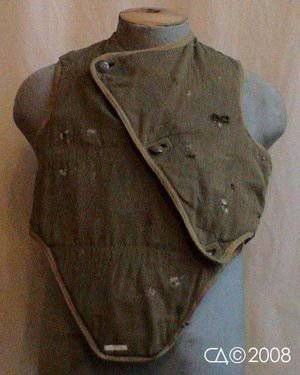
The protective composition of the body armor was a hexagonal plates which were made of aluminum alloy and were placed in a mosaic. Behind them were layers of nylon fabric, as well as a lining of batting. These vests protected from the fragments and bullets of the 7,62 cartridge, which were released from the 50 meters from a submachine gun (PPS or PPSh).
At the beginning of the war in Afghanistan, several such armor vests entered the units of the 40 Army.
But, the complex construction of protection, which consists of a large number of hexagonal elements with special chamfers, which ensured their overlap, considerable weight and low level of protection for a long time buried this attempt, as well as the idea of creating individual armor in the USSR.
In 50-60-x, VIAM created two bullet-resistant body armor with weight 8-12 kilograms: steel body armor and two-layer armor vest from aluminum alloys (the front layer was made of alloy B96C1 and the rear one was AMg6). Around 1000 serially produced body armor were sent to six HE. In addition, by special order, the KGB produced two body armor for N.S. Khrushchev, First Secretary of the Central Committee of the CPSU, before his visit to Indonesia.
About body armor in our country was remembered later 10 years. The initiator was the Ministry of Internal Affairs of the USSR, which faced a dilemma - try to create domestic vests or buy imported ones. Problems with foreign currency in the country have become the reason for choosing to start their own development. With the request to develop a body armor similar to the police vest of the TIG company (Switzerland), the leadership of the Ministry of Internal Affairs turned to the Scientific Research Institute of Steel. The ministry also provided a sample of body armor.
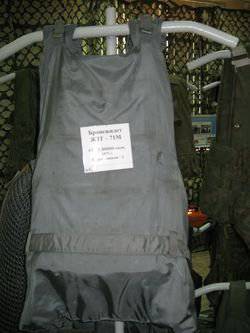
In a scientific research institute of the Steel in a year created and let out the first militia bullet-proof vest which received the name ZZT-71. Due to the use of high-strength titanium alloy in its design, the level of protection significantly exceeded the level set by the customer. On the basis of this body armor, they created several modifications, including ZhZT-71М, as well as a bulletproof vest ZhZL-74 designed against cold steel.
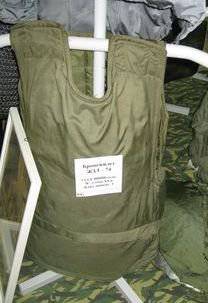
At that time, the bulletproof vest ZhZT-71M was unique because it protected it from pistol and rifle bullets. At the same time, the kinetic energy of the rifle bullets exceeded the energy of the bullet fired from the TT pistol almost 6 times.
For this body armor had to develop technology specials. rolling titanium, which provided a combination of viscosity and high strength needed to realize the protective qualities of titanium armor. Also, in this bulletproof vest, a sufficiently powerful shock absorber was used (thickness about 20 mm). This shock absorber was designed to reduce the level of so-called over-graded injuries, that is, injuries during non-penetration of armor. In these vests used the so-called "scaly" or "tiled" layout elements of armor. The disadvantages of this scheme include the presence of a large number of joints-ceilings, which increase the likelihood of "diving" of a bullet or penetration of a knife. In order to reduce this probability, in the ZhZT-71М armor elements in a row were riveted to each other semi-movably, and their upper edges had specials. tabs traps that prevent the penetration of a knife or bullet between the rows. In ZhZL-74, this goal was achieved due to the fact that the elements made from aluminum alloy specially designed for body armor were arranged in two layers. In this case, the “scales” in the layers were oriented in different directions. This ensured high reliability of protection against any types of cold weapons. Today, the construction of the protection of data vests may seem imperfect and complex. However, this was due not only to the lack of experience of the developers of body armor and the lack of protective materials used today, but also to significantly overestimated requirements for protection against knives and the required area of protection.
By the middle of the 70-x data armor vests equipped many units of the Interior Ministry. Until the middle of the 80's, they remained virtually the only means of police protection.
From the middle of the 70-s, the SRI of Steel was entrusted with a large cycle of work to equip the special units of the KGB, which later became known as Alpha groups. We can say that none of the other customers of body armor have brought so much valuable into the emerging look of body armor, as the staff of this closed department. There was no such word as "trifle" in the lexicon of these units. At the critical moment, any little thing could be fatal, so the thoroughness with which the new products of individual body armor worked together, to this day, is a matter of respect. The most complex ergonomic medical tests, scrupulous evaluation of operating parameters in various unexpected situations, a huge amount of tests of the protective qualities of various armor options - were the norm here.
The first generation of army bulletproof vests.
As for army vests, here until the end of the seventies, the work did not come out of the search phase. The main reasons for this were the lack of light armor materials and the strict demands of the military. All previous models of domestic and imported body armor used ballistic nylon or high-strength nylon as the basis. Alas, these materials, at best, provided an average level of anti-shatter resistance, and were not able to provide high protection.
In 1979, a limited contingent of Soviet troops was introduced into Afghanistan. The events of that time showed that the troops needed to provide assistance to civilians, and fight with armed rebels. In Afghanistan, hastily sent the first series of new bulletproof vests 6B2. This body armor was created in 1978 in the Scientific and Research Institute of Steel together with TsNIISHP (Central Institute of the Clothing Industry). It used constructive solutions for body armor ZZT-71M, which was developed by order of the Ministry of Internal Affairs. In 1981, a bullet-proof vest was taken to supply the USSR Armed Forces under the name F-81 (GRAU index - 6B2). The protective composition of the body armor consisted of titanium plates ADU-605-80 having a millimeter thickness 1,25 (19 on the chest, including two rows in the 3 plate in the 2 layer) and a ballistic thirty-layer screen made of TSVM-J aramid fabric. With a weight of 4,8 kg, the body armor provided protection against pistol bullets and shrapnel. He could not resist bullets fired from long-barreled weapons (bullets from the 7,62xNNXX cartridge had a protective composition pierced already at a distance of 39-400 m). By the way, a curious fact. This bulletproof vest cover was made of nylon fabric, and for fasteners used fashionable at the time, Velcro. This gave the body armor a “foreign” look and gave rise to rumors that these body armor had been acquired abroad — not in the GDR, not in the Czech Republic, or even in a capitalist country.
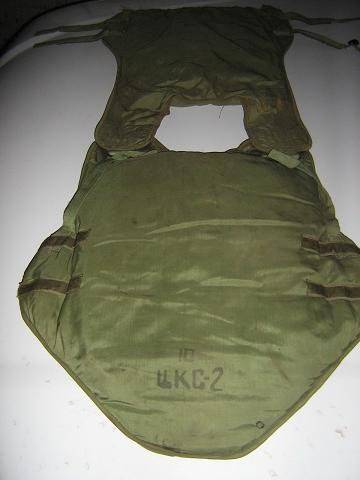
In the course of the hostilities, it became clear that the Z-81 body armor could not provide optimal protection for manpower. In this regard, the armor began to do armor 6B3TM. The protective data package of body armor consisted of 25 plates (13 on the chest, 12 on the back) ADU-605T-83 made of titanium alloy BT-23 (thickness 6,5 millimeters) and 30-layer fabric bags from TVSM-J. Since the weight of the body armor was 12 kilogram, it was replaced with 6B3TM-01 body armor with differentiated protection (chest - from small arms, back - from pistol bullets and shrapnel). The construction of body armor used 6B3TM-01 13 plates ROV-605T-83 (alloy BT-23, 6,5 mm thickness) at the front, as well as plates ROV 12-605-80 (alloy BT-14, 1,25 mm thickness) at the rear; 30-ply fabric bags from TVSM-J on both sides. The weight of this body armor was about 8 kilogram.
The bullet-proof vest consisted of a front and back, which are connected by a textile fastener in the shoulder area and a belt-and-buckle fastener designed for height adjustment. The sides of the product consist of covers, with fabric protective pockets located in them and blocks of pockets with armor elements. On the covers there are pockets outside: in front there is a chest pocket and pockets for four shops, on the back - for the cloak-tent and 4-x hand grenades.
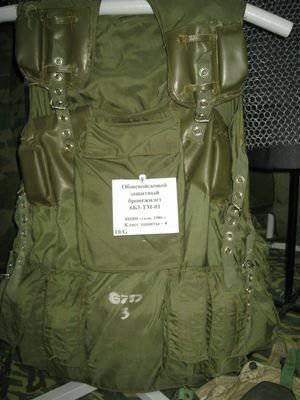
An interesting feature of 6B3TM body armor (6B3TM-01) is that it was made of titanium armor with hardness differentiated in thickness. Roughness in the alloy was achieved by a unique titanium processing technology using high-frequency current.
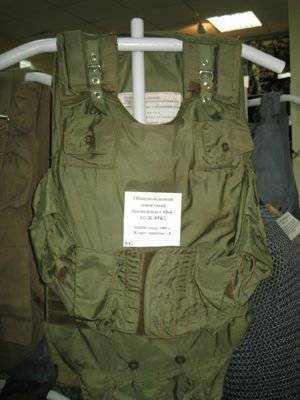
In 1985, these body armor were adopted under the designation Ж-85Т (6Б3ТМ) and Ж-85Т-01 (6Б3ТМ-01).
In 1984, the 6B4 body armor was launched into mass production. In 1985, the body armor was adopted under the designation ZH-85K. The bulletproof vest 6B4, unlike 6B3, had ceramic plates, not titanium plates. Through the use of ceramic protective elements, the 6B4 body armor provides protection against armor-piercing incendiary and bullets with a thermally strengthened core.
The 6B4 bulletproof vest was provided with circular protection from splinters and bullets, but its weight depending on the modification ranged from 10 to 15 kg. In this regard, having gone the way of the 6B3 body armor, they created a lightweight version of the body armor - 6B4-01 (Ж-85К-01) having a differentiated protection (chest - from fragments and bullets of small arms, back - from fragments and pistol bullets).
The 6B4 bulletproof vest series included several modifications that differed in the number of protective plates: 6B4-O - on 16 on both sides, weight 10,5 kg; 6B4-P - on 20 on both sides, weight 12,2 kg; 6B4-С - 30 in front and 26 in rear, weight 15,6 kg; 6B4-01-О and 6B4-01-П - 12 plates in the back, weight 7,6 kg and 8,7 kg, respectively. Protective elements - 30 layers of fabric TVSM and ceramic plates ADU 14.20.00.000. The 6B4-01 vests on the back use ADU-605-80 plates (titanium alloy BT-14) with a thickness of 1,25 mm.
The bulletproof vest 6B4 consists of two parts, connected by a textile fastener in the shoulder area and equipped with a belt-and-buckle fastening that allows you to adjust the size of growth.
The front and back of the body armor consist of covers in which a fabric protective pocket (back), pocket (front) and blocks of pockets with armor elements are placed. This body armor is equipped with two spare elements of body armor. In contrast, the 6B3TM in the case of the 6B4 product is missing a chest pocket and has an elongated chest section that protects the lower abdomen. In later models there is a splinter collar.
The final in a series of vests of the first generation of domestic production is the 6B5 series, which was created by the Steel Institute in 1985. To this end, the institute conducted a series of research projects to determine standardized standard means of individual armor protection. The 6B5 body armor series was based on previously developed and in service products. It included 19 modifications that differed in purpose, level and area of protection. A distinctive feature of this series was the modular principle of protection. That is, each subsequent model could be formed using unified protective nodes. Modules based on fabric structures, ceramics, steel and titanium were used as protective nodes.
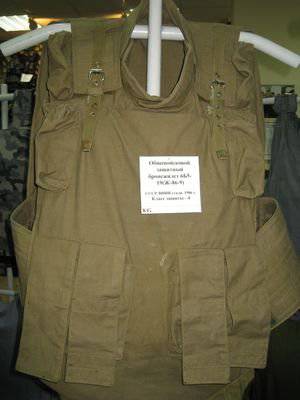
Body armor 6B5 in 1986 was adopted under the designation F-86. 6B5 was a case in which soft ballistic screens (TSVM-J fabric) and so-called circuit boards were placed to accommodate the armored plates. The protective composition used armor panels of the following types: titanium ADU-605-80 and ADU-605T-83, steel ADU 14.05 and ceramic ADU 14.20.00.000.
The covers of the early models of body armor were made of nylon fabric and had different shades of gray-green or green. There were also parties with covers of cotton fabric with camouflage pattern (two-color for the units of the Internal Troops of the USSR Ministry of Internal Affairs and the KGB, and three-color for the marines and airborne forces). The bulletproof vest 6B5 was produced with the camouflage pattern "Flora" after the adoption of this general military color.
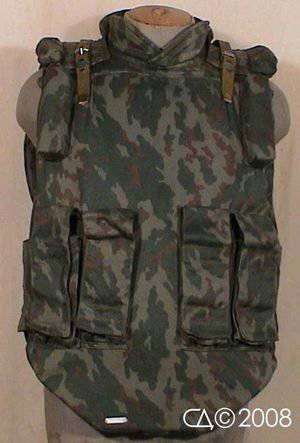
The bulletproof vests of the 6B5 series consist of a front and a back, which are connected by a textile fastener in the shoulder area and have a belt buckle attachment for adjusting the size of the height. Both parts of the product consist of covers, with fabric protective pockets located in them, blocks of pockets and armored elements. When using water-repellent covers for protective pockets after exposure to moisture, protective properties are retained. The bulletproof vest 6B5 has in its kit two water-repellent covers for protective pockets, two spare armored elements and a bag. All models of the series are equipped with an anti-splinter collar. The body armor case on the outside has pockets for weapon elements and machine gun stores. In the shoulder area there are rollers that prevent the gun belt from sliding.
The main modifications of the 6B5 series:
6B5 and 6B5-11 - provides protection for the back and chest against bullets from APS, PM pistols and shards. Protective package - 30 layers of fabric TSVM-DJ. Weight - 2,7 and 3,0 kilograms, respectively.
6B5-1 and 6B5-12 - provides back and chest protection from APS, TT, PM, PSM pistols and shrapnels, has enhanced splinter resistance. Protective package - 30 layers TSVM-DJ and titanium plates ADU-605-80 (thickness - 1,25 mm). Weight - 4,7 and 5,0 kilograms, respectively.
6B5-4 and 6B5-15 - provides back and chest protection from small arms bullets and shrapnel. Protective package - ceramic plates ADU 14.20.00.000 (22 in front and 15 in the back) and 30-layer fabric package from TSVM-DZH. Weight - 11,8 and 12,2 kilograms, respectively.
6B5-5 and 6B5-16 - provides protection for: chest - from fragments and small arms bullets; back - from pistol bullets and shrapnel. Protective package: chest - 8 titanium elements ADU-605Т-83 (thickness 6,5 mm), 3 to 5 titanium elements ADU-605-80 (thickness 1,25 mm) and 30-layer fabric bag made of TSVM-DJ; back - 7 titanium elements ADU-605-80 (thickness 1,25 mm) and 30-ply fabric bag made of TSVM-DJ. Weight - 6,7 and 7,5 kilograms, respectively.
6B5-6 and 6B5-17 - provides protection for: chest - from fragments and small arms bullets; back - from pistol bullets and shrapnel. Protective package: chest - 8 steel elements ADU 14.05. (thickness 3,8 (4,3) mm), from 3 to 5 titanium elements ADU-605-80 (thickness 1,25 mm) and 30-layer fabric bag made of TSVM-DJ; back - 7 titanium elements ADU-605-80 (thickness 1,25 mm) and 30-ply fabric bag made of TSVM-DJ. Weight - 6,7 and 7,5 kilograms, respectively.
6B5-7 and 6B5-18 - provides protection for: chest - from fragments and small arms bullets; back - from pistol bullets and shrapnel. Protective package: chest - titanium plates АДУ-605Т-83 (thickness 6,5 mm) and 30-layer fabric bag made of ТСВМ-ДЖ; back - 30-ply fabric bag made of TSVM-J. Weight - 6,8 and 7,7 kilograms, respectively.
6B5-8 and 6B5-19 - provides protection for: breasts - from fragments and bullets of small arms (the third class of defense of the Russian Ministry of Defense); backs - from bullets of pistols APS, PM and splinters. Protective package: chest - 6 14.05 steel ADU plates (3,8 thickness (4,3) mm) and from 5 to 7 titanium plates ADU-605-80 (thickness 1,25 mm) and 30-layer fabric bag from TSVM-DJ; back - 30-ply fabric bag made of TSVM-J. Weight - 5,7 and 5,9 kilograms, respectively.
The 6B5-11 and 6B5-12 bulletproof vests provided splinter protection. These body armor were intended for the calculation of rocket complexes, artillery shells, self-propelled artillery installations, support units, staffs, etc.
6B5-13, 6B5-14, 6B5-15 bulletproof vests provided all-round protection against bullets and were intended for personnel of the units that performed short-term specials. tasks (assault and the like).
The 6B5-16, 6B5-17, 6B5-18, 6B5-19 bulletproof vests provided differentiated protection and were intended for the personnel of the Airborne Forces, SV and naval infantry units of the Navy.
After the adoption of bulletproof vests of the 6B5 series to supply, the rest of the bulletproof vests that were previously taken for supplying were decided to leave in the troops until full replacement However, 6B3ТМ-01 body armor remained in the army in 90-ies, and was actively used in local conflicts and wars in the entire former USSR. The 6B5 series was produced until 1998, and was removed from the supply only in 2000, but remained in the army until fully replaced by modern bulletproof vests. Body armor series "Beehive" in various versions to date are in parts.
New country - new body armor.

Initially, 90's development of personal protective equipment for the armed forces stalled, funding for a large number of promising projects was curtailed. However, the rampant criminality was the impetus for the development and production of individual armor for private individuals. During these years, the demand for them significantly exceeded supply, which is why companies offering these products began to appear in Russia. The number of such firms has already exceeded 3 in 50. The apparent simplicity of the body armor was the reason that a lot of dilettantes, and sometimes outright charlatans, got into this sphere. The quality of body armor dropped sharply. Experts of the Scientific Research Institute of Steel, having taken one of such “bullet-proof vests” for evaluation, found out that simple food grade aluminum was used as a protective element.
In this regard, in 1995, in the field of personal protective equipment made a significant step - GOST 50744-95 appeared, which regulated the classification of those. requirements for body armor.
Even in these difficult years for the country, progress was not in place, and the army needed new body armor. There was such a thing as a basic set of individual equipment (BKIE), in which a significant role was assigned to body armor. The first BKIE "Barmitsa" included the project "Zabara" - a new army body armor, which came to replace the series "Beehive".
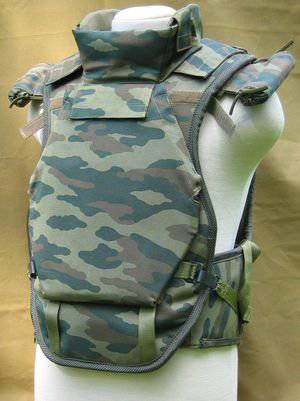
In the framework of the project "Visor" created armor vests 6B11, 6B12, 6B13, which were adopted in 1999 year. These body armor, in contrast to the times of the USSR, were developed and produced by a large number of organizations. In addition, they differ significantly in characteristics. Bullet-proof vests were manufactured or manufactured by Scientific Research Institute of Steel, JSC Breastplate, NPF Tekhinkom, CVM Armokom.
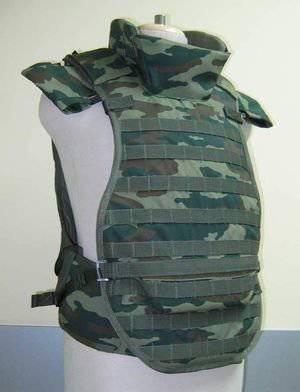
6B11 is a bullet-proof vest 2-th class of protection with weight 5 kg. 6B12 - 4-th class of protection for the chest, 2-th - for the back. Bulletproof vest weight 8 kg. 6B13 provides all-round protection for the 4 class, with a mass of 11 kg.
The bullet-proof vest of the series "Visor" consists of the thoracic and dorsal sections, which in the shoulder area are connected by nap fasteners and in the belt area by a belt-and-buckle joint. Fasteners allow you to adjust the size of body armor for growth. The connection of the sections in the belt is a nap fastener and a belt with a hook and carbine. Sections of body armor consist of external covers. Inside they are protective fabric screens with outer pockets in which armor elements are placed (one on the back section and two on the chest section). The chest section is equipped with a folding apron providing protection for the groin. The reverse side of both sections is equipped with dampers, which provide a reduction in contusion impact. The damper is designed in such a way that natural ventilation of the vesting space is ensured. The vest is equipped with a two-piece collar. The collar protects the neck from splinters. Parts of the collar are connected by nap fasteners that allow you to adjust their position. The adjusting units of the Zaralo series bulletproof vests are compatible with the similar units of the 6Sh92-4 transport vest, which is designed to accommodate equipment elements that are part of the wearable part of the personal equipment of the naval, naval airborne forces, etc.
Depending on the modification, the bulletproof vest is equipped with quick-changeable fabric, steel or organic ceramic panels "Granit-4". The protective package has a design that eliminates ricocheting at an approach angle of a bullet from 30 to 40 degrees. Bulletproof vests also provide protection for the military’s neck and shoulders. The top of the body armor has a water-repellent impregnation, protective camouflage paint, and does not support combustion. All materials used in the manufacture of body armor are resistant to aggressive fluids; explosion-proof, non-flammable, non-toxic; do not irritate the skin with direct contact. Body armor in this series can be used in all climatic zones. Retain their protective properties in the temperature range from - 50 ° C to + 50 ° C, and when exposed to moisture.
Russian body armor of the XXI century.
At the beginning of the century, a new stage of development of basic sets of individual equipment - the project "Barmitsa-2" - began. In 2004, in the framework of this project, the Permianka-O combat propulsion kit (combat protective kit) was adopted for supply under the designations 6Б21, 6Б22. This kit is designed to protect soldiers from small arms, circular protection from shell fragments, grenades, mines, protects against local zabronevy contusion injuries, weathering, thermal factors, mechanical damage. In addition, Permyachka-O provides camouflage, deployment and further transportation of ammunition, weapons and other elements necessary for the conduct of hostilities. The Permachka-O combat security kit includes:
- jacket and trousers or protective overalls;
-belt vest;
-protective helmet;
- protective mask;
-protective glasses;
- vest transport universal 6Sh92;
- ventilated linen;
-protective boots;
-racket backpack 6Sh106, as well as other elements of equipment;
- the kit also includes summer and winter camouflage suits.
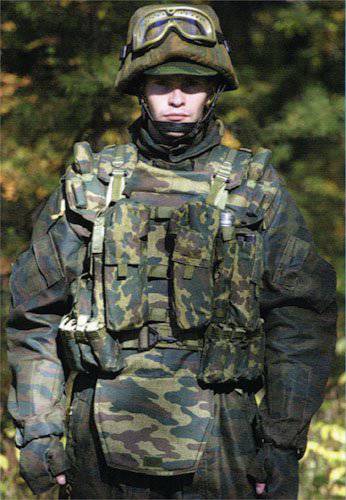
Depending on the performance, the base of the costume is made up of protective trousers and a jacket or overalls. These elements protect from small fragments (mass of 1 fragments, grams, at a speed of 140 meters per second) as well as open flame (for at least 10 seconds). Helmet and body armor are made on the first level of protection. Able to protect against edged weapons, as well as fragments weighing 1 grams at a speed of 540 meters per second. To protect the vital system (vital organs) from being hit by bullets, the body armor is reinforced with ceramic or steel armor panels of the third (6B21-1, 6B22-1) or fourth level of protection (6B21-2X, 6B22-2, modifications XNUMXBXNUMX-XNUMX, XNUMXБXNUMX-XNUMX, XNUMXBXNUMX-XNUMX, XNUMXBXNUMX-XNUMX, modifications XNUMXBXNUMX-XNUMX, XNUMXБXNUMX-XNUMX, XNUMXBXNUMX-XNUMX, XNUMXBXNUMX-XNUMX, modifications XNUMXBXNUMX-XNUMXXNXXXXNUMX-XNUMXBXNUMX-XNUMX)
Used in the "Breastplate-4A" and "Breastplate-4K" armor panels of the fourth level of protection are composite designs of ergonomic shape. They are made on the basis of aramid fabric, polymer binder, and aluminum oxide or silicon carbide (“Breastplate-4A” or “Breastplate-4K”, respectively).
The protective properties of the combat protective kit do not change at temperatures from –40 to + 40 C and also remain after prolonged exposure to moisture (sleet, rain, etc.). The outer fabric of the elements of the UPC and the raid backpack are water-repellent impregnated.
The Permian-O BZK is produced in six main modifications: 6Б21, 6Б21-1, 6БXNNXX-21; 2B6, 22B6-22, 1B6-22.
The kit has considerable mass, but it should be remembered that it consists of 20 elements. The weight of the anti-splinter kit (modifications 6B21, 6B22) is 8,5 kilogram, the BZK reinforced by an armor block of the third level - 11 kilogram; UPC fourth level - 11 kilogram.
On the basis of the UPC, a sniper-camouflage set is made, which includes additional masking elements - a masking mask, a set of camouflage capes, masking tape for a rifle, and so on.
BZK "Permyachka-O" was tested in the North Caucasus during hostilities. There he showed, in general, a positive result. Minor flaws mainly related to the ergonomics of individual elements of the kit.
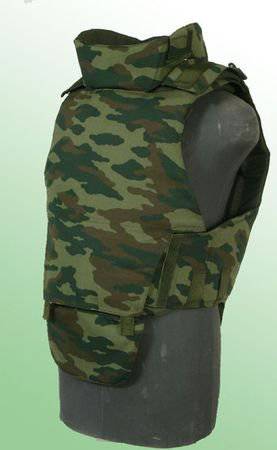
The SPE CLASS 2003 in the year developed a general armor vest, adopted in 2004 for the supply under the designation 6B23.
The vest consists of two sections (chest and dorsal). Between themselves, they are interconnected by means of connectors in the shoulder area and the outer part of the waist fastening and a flap valve on the belt. Between the layers of protective screens are pockets in which fabric, steel or ceramic panels can be placed. The vest has a collar to protect the neck. Belt mounts in the side have protective shields that protect the sides. The inner part of the sections has a ventilation-damping system in the form of polyethylene foam vertical strips ensuring a reduction in the contusion (over-graded) impact as well as ventilation in the old-fashioned space. This body armor can be combined with the 6ShX104 or 6Sh92 transport vest.
The bulletproof vest can be equipped with armor panels of various levels of protection. Chest - 2 protection level (tissue), 3 protection level (steel), 4 protection level (ceramic). Spinal - steel or fabric.
Depending on the type of armor used, the mass of the body armor varies. A bulletproof vest that has 2 chest and back protection classes weighs 3,6 kg, 3 chest protection class and 2 back class - about 7,4 kg, 4 chest protection class and 2 back class - 6,5 kg, 4 chest protection class and 3 back class - 10,2 kg.
The 6B23 bulletproof vest had such a good design that the Defense Ministry accepted it as the main means of individual armor for the personnel of the marines of the Navy, Airborne Forces, and others. However, the rearmament of the Russian army, as always, is slow and the troops receive new body armor in limited quantities. As before, special forces, marines, and airborne troops have priority in supply.
The next stage of development is the development and implementation of the basic set of individual equipment "Warrior", which is more effective than the "Barmitsa" in 8-10 times.
Special body armor.
However, not everyone can use combined arms body armor. For example, bulletproof vest 6B23 will cause inconvenience to the crew of a combat vehicle, since it makes it difficult to leave tank or BMP through hatches, in the car itself it restricts movement. But the crew of such machines require protection. First of all, from the damaging elements that occur when hit by ATGMs, shells, grenades, as well as from thermal effects.
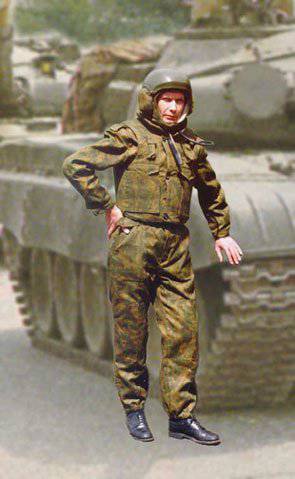
For crews of armored vehicles in 2003, the Cowboy security kit (6B15) was adopted for supply.
Currently, the protective kit "Cowboy" is produced by two organizations: the firm ARMOCOM and the Scientific Research Institute of Steel.
The kit includes:
- anti-splinter body armor (first class protection);
- a fireproof suit (scientific research institute of the Steel) or overalls (ARMOCOM);
-the splinter plate on the tank headset (ARMOCOM) or the tank headset TSH-5 (SRI Steel).
The mass of the entire set of 6 kilogram (Research Institute of Steel) or 6,5 kilogram (ARMOCOM).
The vest consists of detachable sections (chest and dorsal) and a turn-down collar. On the case of a bullet-proof vest there is an evacuation device and patch pockets designed to accommodate regular equipment.
The kit provides protection for the groin, shoulders and neck. On it can be placed and transported staff weapons and other items that are included in the equipment of military personnel of this kind of troops. "Cowboy" provides the performance of functional duties of a member of the crew of the armored vehicle for two days.
Armored elements are made of ballistic fabric for which the high-strength domestic fiber Armos with oil-, water-repellent treatment is used as the basis. External covers of the body armor, overalls and linings are made of fire-resistant fabric and have a camouflage color. Open flame resistance is 10-15 seconds. The protective properties of the kit are preserved during precipitation, after 4-x multiple decontamination, disinfection, and degassing, and after exposure to special liquids and fuels and lubricants used in the operation of armored vehicles. The temperature range is from minus 50 ° С to plus 50 ° С.
"Cowboy" has a camouflage color, and also does not increase the unmasking signs of equipment of the crews of armored vehicles outside military equipment.
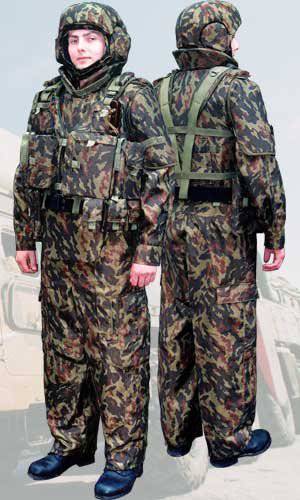
Later, ARMOKOM presented the further development of the 6B15 kit - the 6B25 kit for the crews of armored artillery and rocket troops. In general, this set repeats 6B15, but it consists of a transport vest, as well as winter trousers and a jacket made of flame retardant fabric.
Also included in the kit is a foot heating tool, which is an insole for shoes, which provides the surface temperature 40-45 ° С.
Command personnel are the next category of military personnel who do not need to wear heavy military armor vests. Body armor 6B17, 6B18 was adopted in 1999 year, and Strawberry-O (6B24) in 2001 year.
The bulletproof vest 6B17 is a non-standard means and is designed to protect military personnel who are carrying out work in the process of guarding objects such as headquarters, commandant's offices, patrol duty, and special purpose cargo escorts in urban environments against splintering and pistol bullets. 6B17 has a general first level protection and fabric second level armor panels. Bulletproof vest weight 4 kg.
A bulletproof vest wearing concealed 6B18 was intended to be worn by junior officers. By weight and level of protection, it repeats 6B17.
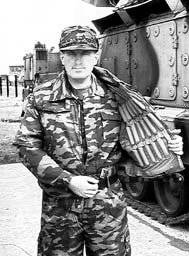
The armored set "Strawberry-O" (6B24) is designed to be worn by senior officers. The kit is available in summer and winter versions: summer - trousers and jacket with short sleeves (4,5 kg), winter - body armor, winter trousers with removable insulation and jacket (5 kg). Protective properties are achieved by using ballistic fabrics, which are used for filing trousers and jackets. Protective armor panels are provided on the back and chest.
In 2008, the above-described body armor was implicated in a scandal. The head of the supply department of the Main Directorate of the Main Directorate of the Main Directorate of the Rocket Artillery Directorate of the Ministry of Defense of Russia purchased for the office from ZAO Artess about 14 thousand protective kits worth 203 million rubles. Subsequently, it turned out that body armor of the second class of protection were penetrated by pistol bullets and shrapnel. As a result, the entire batch of armor vests supplied by the Artest to the Ministry of Defense were declared unfit. By decision of the investigation they began to withdraw from warehouses. This incident was the reason for initiating a criminal case against the general and the leadership of the company "Artess".
"NGO Special Materials" in 2002 was presented at the state. tested two body armor for sailors. In 2003, they were accepted for purchase under the designations 6B19 and 6B20.
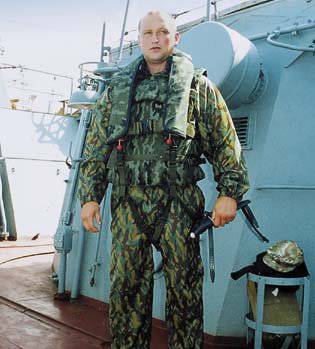
The bulletproof vest 6B19 is intended for the marine infantry and watch-keeping outdoor combat posts of ships. During the first tests, the sailors immediately assessed the quality of the vests, their improved ergonomics, the strength of the armored plates (the plates could not be punched out of the SVD rifle with an LPS bullet at a distance of 50 meters) and covers. The Marines were also pleased with the results of the pilot operation of 6B19 body armor. Even in spite of the fact that they had to “sweat” on them at the marches, but still it was harder for the marines dressed in regular flak jackets. A special feature of the 6B19 design is a special rescue system, due to which a soldier who falls into the water without consciousness will not drown. The system automatically inflates two cameras and turns the person upside down. NSZH consists of two chambers, automatic gas filling systems, has a margin of positive buoyancy 25 kg.
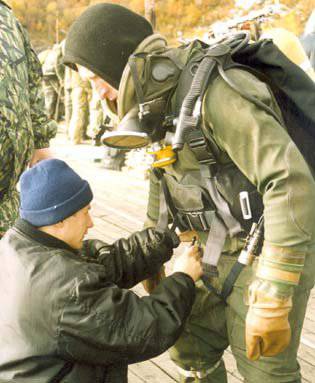
6B20 body armor was designed for naval combat swimmers fleet. 6B20 consists of two main systems (protective system and buoyancy compensation system) as well as several subsystems.
The protective system protects vital organs from cold weapons, bullets from underwater small arms and from mechanical damage that are possible during diving operations. The protective system of the body armor is made in the form of a chest panel placed in the case. The design of the suspension system allows its use separately from the protective module.
The buoyancy compensation system allows you to adjust the diver's buoyancy at different depths and maintain the diver on the surface of the water. The system consists of a buoyancy chamber with herbal-safety valves, an air supply control system, a rigid mounting back, an outer cover, a load drop system and a suspension system. Depending on the breathing apparatus used, the buoyancy chambers are filled from the self-contained air cylinder or from the breathing apparatus cylinders through the inflator (buoyancy control device).
The vest does not melt when exposed to an open flame for 2 seconds and does not sustain combustion. The materials used in the manufacture, resistant to the effects of sea water and petroleum products.
The design of the body armor ensures the reliability of its fixation on the body of swimmers when jumping into the water from a height of 5 meters with weapons in various types of diving equipment and special equipment. In addition, it does not interfere with the independent rise of the swimmer in an inflatable boat, platform or life raft that rise above water to 30 centimeters. The maximum average time that combat swimmers need to overcome the 1 distance a mile submerged in flippers with body armor does not exceed the standard time to cover this distance without body armor.
The 30-year-old confrontation between the developers of the means of protection and the means of destruction has led to some equilibrium. However, as life shows, it is unlikely to be long. Objective laws of development are forcing weapons developers to look for ways to increase the damaging power of weapons, and these paths have begun to take shape.
However, the defense does not rest on its laurels. Today, the largest manufacturers and developers of body armor, such as NPO Tekhnika (NIIST MIA), Scientific Research Institute of Steel, Scientific Production Association Spetsmaterialy, Bremen Armokom are searching for new protective materials, new protective structures, are exploring new principles of individual armor. There is every reason to think that the expected increase in the power of destruction will not surprise the developers of protection.
Information